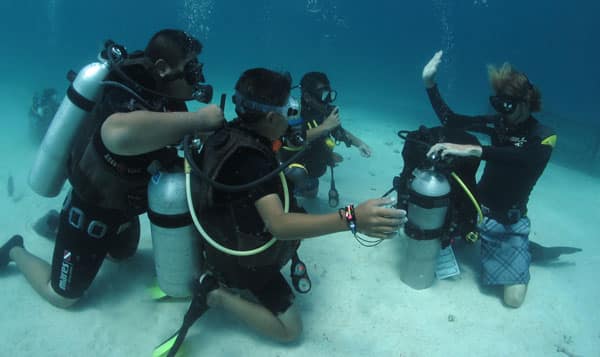One of a SCUBA divers most memorable training moments is often their first ‘deep dive’. The thrill and adrenaline of knowing that you will be going more than 18 meters below the ocean waves, below the realm of most swimmers or snorkelers, and into the territory of the ocean abyss. But upon descending, most quickly realize that their fears of the deep are unsubstantiated, and in fact going to 30 meters is not that much different from 16 meters in terms of perceivable effects to the human body. For this reason, dive instructors around the globe have been coming up with fun, interactive, and informative ways to show divers the physical effects of descending down where pressures are more than double that of the surface.
Some of the most common tools used are color charts, which allow divers to see the differences in light levels at depth due to the preferential absorption of red light. Another technique is to get divers to take a short quiz at depth, to show how brain speed can be slowed down due to the biological effects of an increased partial pressure of inert nitrogen gas. Unfortunately, a more recent practice has been the act of bringing down an uncooked egg to show the effects of increased pressure. In this technique, the egg is brought down to depth and cracked, at which point the egg white can be removed and the yolk remains intact. Generally, then the students will have a moment to feel or toss around the egg yolk, before continuing the dive.
With hundreds of thousands of people learning to dive each year, this can add up to a lot of eggs introduced to fragile coral reef dive sites. The act of using an egg to demonstrate the effects of increased pressure is not a sanctioned skill by any leading certification organization, and may also have detrimental effects to marine life. Some of the reasons why this practice should be discontinued include:
- Breaking eggs under water violates two rules and regulations, the first being fish feeding and the second being throwing food waste into the sea in a coral reef area. These practices are not allowed on most reefs as it contributes to increased nutrient and macro-algae levels which contributes to coral reef degradation. Herbivores and detritivores fish which should be eating algae and waste off the reef instead are eating food from boats or divers. The behavior of the fishes also changes, leading in some cases to attacks on divers or snorkelers (for example, see the Phuket case of a diver who lost a finger from a moray eel who was accustomed to being fed sausages by divers.)
- Uncooked chicken eggs, especially those which are industrially produced, contain many foreign bacteria, viruses, hormones, anti-biotics, and prions that can increase the prevalence of disease among fish, coral and other marine life.
- As the eggs are brought down in plastic bags and often wrapped in paper it contributs to marine debris.
- The egg technique is not the most effective nor educational means of teaching the deep dive, and does little to truly teach divers about the environment. Techniques using sanctioned teaching materials (such as color charts) or reusable items (such as inflatable sports balls) are already adequate and have been proven to increase a divers understanding of the effects of diving below 18 meters while still being fun and interactive.

